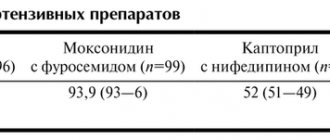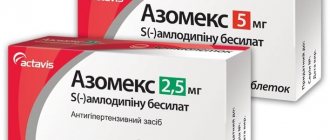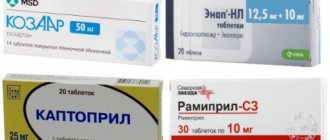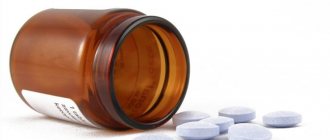Pharmacological properties of the drug Corinfar
Calcium antagonist of the 1,4-dihydropyridine group. Blocks the transmembrane entry of calcium ions through selective voltage-dependent “slow” L-channels into smooth muscle cells of arterial vessels and cardiomyocytes. Nifedipine, like all dihydropyridine calcium antagonists, has pronounced selectivity for vascular smooth muscle compared to the myocardium. The main hemodynamic effect of the drug is systemic peripheral vasodilation, leading to a decrease in systemic peripheral vascular resistance, which determines its antihypertensive effect. The antianginal effect of nifedipine is associated with a decrease in cardiac afterload and a decrease in myocardial oxygen demand due to systemic vasodilation. In addition, the drug has a direct vasodilating effect on the coronary arteries of the heart, preventing the development of vasospasm. The effect of nifedipine is due to the improvement of diastolic relaxation of the left ventricle (normalization of diastolic filling). Other effects include a slight diuretic effect that blocks the effect on platelet aggregation. According to research, long-term use of the drug inhibits the development of atherosclerotic changes in blood vessels. After oral administration on an empty stomach, the active substance nifedipine is quickly and almost completely (90–100%) absorbed into the gastrointestinal tract. When administered sublingually, the effect of nifedipine begins to appear after 5–15 minutes, and when taken orally, after 10–30 minutes. The maximum effect appears 30–90 minutes after oral administration and persists for 4–6 hours. In the retard form, the drug has an effect for more than 8 hours. After a single dose of 2 tablets of Corinfar (20 mg), the therapeutic concentration in the blood (10 ng/ml) is achieved after 30 minutes, the maximum concentration in the blood plasma (75 ng/ml) is determined after 1.6 hours, after which a gradual decrease is noted. After a single dose of 1 tablet of Corinfar Retard (20 mg), the therapeutic level of the drug in the blood plasma is achieved after 60 minutes, the maximum concentration after 2.4 hours; a stable equilibrium concentration (from 20 to 60 ng/ml) is maintained for 6 hours. 10 hours after administration of Corinfar Retard, an active concentration of 13 ng/ml remains in the blood plasma, which gradually decreases to 2 ng/ml within 24 hours . The absolute bioavailability of nifedipine is 50–70%. A high first-pass effect through the liver is noted, which causes significant fluctuations in the concentration of the active substance in the blood in some patients. About 95% of the drug binds to blood plasma proteins. The time to reach the maximum concentration in the blood plasma for the prolonged form of the drug is 4–6 hours, the duration of action is up to 24 hours. In the liver, nifedipine is almost completely metabolized, primarily due to oxidative and hydrolytic processes; the resulting metabolites do not have pharmacological activity. In humans, 3 active metabolites of nifedipine are detected. In the form of metabolites, nifedipine is excreted from the body mainly through the kidneys (60–80%), the remaining metabolites are excreted in feces, less than 0.1% of the active substance is found in urine. The half-life is 5–11 hours. Accumulation of the drug in the body during long-term treatment with therapeutic doses has not been described. With reduced liver function, an increase in the half-life of the active substance and a decrease in total plasma clearance are noted; in such cases, a reduction in the dose of the drug is required. In small amounts, nifedipine penetrates the blood-brain barrier, probably the placental barrier, and also passes into breast milk. During hemodialysis, it is practically not removed from the blood plasma; it can be removed through plasmapheresis.
Analogues and substitutes
"Corinfar" is an original drug produced by . If the medicine is not available in the pharmacy chain, patients are prescribed analogues - products with the same chemical composition, which differ in cost, name and manufacturer.
Drugs that replace Corinfar:
- "Nifekard" (Slovenia);
- "Kordaflex" (Hungary);
- "Nifebene" (Germany), available in the form of drops and capsules for oral administration;
- "Kordafen" (Poland);
- "Kordipin" (Slovenia);
- "Phenigidin" (Ukraine);
- "Nifedipine" (domestic drug).
In case of intolerance or contraindications to Corinfar, it is recommended to use substitutes - drugs with a similar therapeutic effect.
Permitted groups of drugs (according to the current register of medicines - RLS) are presented in the table.
| Drug class | Active substance | Trade name of analogue drugs |
| Phenylalkylamine representatives of the BKK class | Verapamil |
|
| Benzothiazepine group of BCC | Diltiazem |
|
| Beta blockers | Metoprolol |
|
| Angiotensin-2 receptor antagonists | Losartan |
|
Use of the drug Corinfar
Corinfar - 1-2 tablets (10-20 mg) 2-3 times a day, maximum daily dose - 80 mg, Corinfar Retard - 1-2 tablets 2 times a day. The tablets are taken without chewing after meals, with a sufficient amount of liquid. The recommended interval between doses is 12 hours and should not be less than 4 hours. Treatment should be carried out for a long time. In patients with liver failure, a dose reduction may be necessary. Corinfar Uno 40 tablets are taken orally, 1 tablet 1 time in the morning during meals, without chewing, with a sufficient amount of liquid (for example, a glass of water). The maximum daily dose of the drug is 2 tablets (80 mg) once a day. The duration of treatment is determined by the course of the disease.
Release form
Corinfar and Corinfar Retard are extended-release tablets that are film-coated, straw-colored, biconvex, round, with a beveled edge; on the section there is a homogeneous yellow substance.
10 such tablets of Corinfar or Corinfar Retard in blisters, three blisters in a cardboard box. Or 50 such tablets of Corinfar or Corinfar Retard in a dark glass bottle, one such bottle in a cardboard box. Corinfar is also available separately in a quantity of 100 tablets in a dark glass bottle and a cardboard box.
Corinfar UNO - extended-release tablets, dark red coated, biconvex, round. 10 such tablets in a blister; 5, 2 or 10 such blisters in a paper pack.
Side effects of the drug Corinfar
Most often, at the beginning of treatment, transient headache, vasomotor reactions (hyperemia of the skin of the face and torso with a feeling of heat) are possible, less often - reflex tachycardia, increased attacks of angina pectoris, swelling of the legs, paresthesia, dizziness, increased fatigue, arterial hypotension; rarely - nausea, feeling of fullness of the stomach, diarrhea, skin itching, urticaria, exanthema, in isolated cases - exfoliative dermatitis, gynecomastia (mainly in older men with long-term use of the drug, goes away after its discontinuation), changes in blood composition (anemia, thrombocytopenia , leukopenia), thrombocytopenic purpura, hyperglycemia (especially in patients with diabetes), myocardial infarction, in isolated cases when using the drug in high doses - myalgia, tremor, transient visual disturbances; in isolated cases with long-term use - reversible gingival hyperplasia, intrahepatic cholestasis, transient increase in serum transaminases, hepatitis.
Overdose
Symptoms: facial flushing, headache, bradycardia/tachycardia , strong long-term decrease in blood pressure, suppression of the sinus node . In severe cases - fainting, coma .
Therapy: symptomatic. As a rule, gastric lavage is performed using activated carbon . The antidote will be calcium preparations - intravenous 10% solution of calcium chloride or calcium gluconate . With a strong decrease in blood pressure, slow intravenous administration of dobutamine, dopamine, norepinephrine or epinephrine . If heart failure occurs, strophanthin . With the development of arrhythmic conditions - isoprenaline , atropine .
Hemodialysis in case of overdose is ineffective; plasmapheresis .
Special instructions for the use of the drug Corinfar
The drug is used with caution in cases of severe arterial hypotension (systolic blood pressure below 90 mm Hg), in decompensated heart failure, hypovolemia, in elderly people (over 60 years of age). The drug is not recommended for use in children. If treatment with nifedipine is suddenly stopped, withdrawal syndrome may develop. In patients with renal failure and patients on hemodialysis, taking the drug may be accompanied by a worsening of the condition. In patients taking the drug, reaction speed and ability to concentrate may decrease. This is especially pronounced at the beginning of treatment, with increasing doses of the drug and with simultaneous consumption of alcohol.
conclusions
The prescription of calcium channel blockers in cardiology is due to the complex effect on the rheological properties of blood, vascular tone, and the conduction system of the heart.
Corinfar is one of the most used medications, which is characterized by a wide range of effects and positive reviews from patients. Convenient dosage, individual dosage regimen and the presence of a prolonged form are the main advantages of the product. The instructions for use of Corinfar define specific indications and restrictions for taking the drug.
Interactions of the drug Corinfar
The effect of the drug is enhanced by the simultaneous administration of other antihypertensive drugs, tricyclic antidepressants, nitrates, cimetidine and ranitidine; when combined with beta-adrenergic receptor blockers, there is a risk of increased arterial hypotension, and in some cases, the occurrence or intensification of signs of circulatory failure; when combined with quinidine, the level of the latter in the blood plasma decreases. Nifedipine increases the concentration of digoxin and theophylline in the blood plasma when used simultaneously.
Compound
| Extended-release film-coated tablets | 1 table |
| active substance: | |
| nifedipine | 10 mg |
| composition component without quantity | |
| excipients: lactose monohydrate - 15.8 mg; potato starch - 15.7 mg; MCC - 15.5 mg; povidone K25 - 2.7 mg; magnesium stearate – 0.3 mg | |
| film shell: hypromellose - 2.88 mg; macrogol 6000 - 0.48 mg; macrogol 35000 - 0.22 mg; quinoline yellow dye (E104) - 0.27 mg; titanium dioxide (E171) - 0.77 mg; talc - 0.38 mg |
Pharmacodynamics
Selective blocker of “slow” calcium channels (SBCC), a derivative of 1,4-dihydropyridine. Has antianginal and hypotensive effects. Reduces the flow of extracellular Ca2+ into cardiomyocytes and smooth muscle cells of the coronary and peripheral arteries; in high doses inhibits the release of Ca2+ from intracellular stores. In therapeutic doses, it normalizes the transmembrane Ca2+ current, which is disturbed in a number of pathological conditions, primarily in arterial hypertension. Does not affect the tone of the veins. Strengthens coronary blood flow, improves blood supply to ischemic areas of the myocardium without developing the “steal” phenomenon, and activates the functioning of collaterals. By dilating peripheral arteries, it reduces peripheral vascular resistance, myocardial tone, afterload and myocardial oxygen demand. It has virtually no effect on the sinoatrial and atrioventricular nodes and has weak antiarrhythmic activity. Increases renal blood flow, causes moderate natriuresis. The negative chrono-, dromo- and inotropic effects are overlapped by reflex activation of the sympathoadrenal system and an increase in heart rate in response to peripheral vasodilation.
The onset of the clinical effect is 20 minutes, its duration is 4–6 hours.



